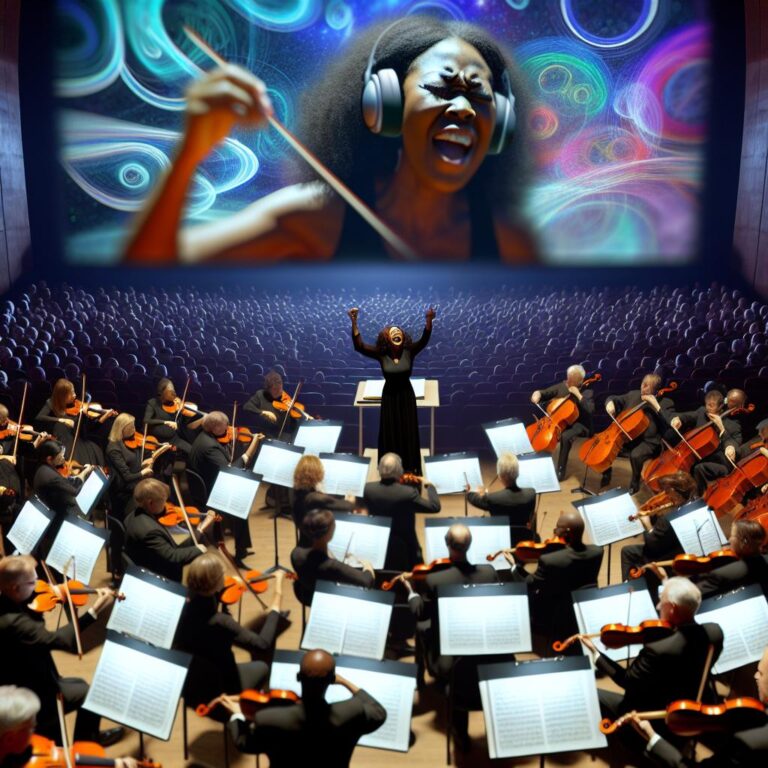
- Influential directors like Steven Spielberg and Martin Scorsese have redefined film storytelling and genre exploration.
- Fritz Lang and François Truffaut shaped sci-fi and French New Wave with “Metropolis” and “The 400 Blows.”
- Raj Kapoor and Melvin Van Peebles influenced romance and blaxploitation cinema.
- Pedro Almodóvar and Emilio Fernández enriched film with cultural narratives from Spain and Mexico.
- Mira Nair and Spike Lee broke boundaries with films addressing social issues.
- Sofia Coppola and Agnès Varda captured youth and femininity with unique styles.
- New talents like Jordan Peele and Greta Gerwig innovate modern cinema with films like “Get Out” and “Lady Bird.”
- Directors often incorporate their cultural backgrounds to create universally appealing stories.
Famous movie directors aren’t just names on a marquee; they are the true game-changers of cinema. Think of icons like Spielberg and Scorsese – they’ve transformed filmmaking with their magic! They shaped film history and continue to influence today’s directors. Curious about directors who inspired new film styles and genres? Ever wondered how storytelling evolved through cinema? Dive in and explore your favorite directors’ influential works!
How Have Influential Directors Shaped Film History?

When we talk about how film history has been shaped, we can’t forget the impact of influential directors throughout history. Directors like Steven Spielberg and Martin Scorsese stand out for changing how we see movies today. Spielberg, with his imaginative storytelling, has brought us classics like “E.T.” and “Jurassic Park.” These movies don’t just entertain; they showcase Spielberg’s ability to blend thrilling action with heartfelt emotion. Scorsese, on the other hand, dives deep into the human soul, exploring themes of crime and redemption. His films like “Taxi Driver” and “Goodfellas” are not only dramatic but also thought-provoking. Together, these directors show how to make cinema that resonates across generations.
Spielberg and Scorsese have left an everlasting mark. But what about those who opened new doors in genre development? Directors like Fritz Lang and François Truffaut come to mind. Lang, with his film “Metropolis,” gave us future visions that still inspire today’s sci-fi movies. His storytelling used shadows and light, which helped create the tense atmosphere in thrillers. Truffaut, famous for the French New Wave, introduced fresh ways to tell stories. Films like “The 400 Blows” gave audiences more personal and realistic slices of life. With their unique skills, both Lang and Truffaut showed how narrative and visual elements can shape a film’s powerhouse.
Other directors have made history by creating new film styles. Raj Kapoor, from India, brought colorful tales of romance with epic qualities to the screen. His works bridge a gap, making them accessible to many viewers. Then there’s Melvin Van Peebles, who pioneered the blaxploitation genre. His films gave a voice to black Americans and explored issues not often seen in the mainstream. Their efforts helped make room for diverse stories and storytellers.
On the international scene, directors like Pedro Almodóvar and Emilio Fernández have enriched film culture with their unique perspectives. Almodóvar paints his films with bold colors, dealing with themes like family and identity. His works are not only vibrant visually but also topically rich, connecting with many people. Similarly, Fernández, a key figure in Mexican cinema’s Golden Age, created beautiful images filled with deep emotion. His films remind us to appreciate our heritage.
Directors also break down barriers and push film in new directions. Take Mira Nair, for example. She brings realism to her films, capturing everyday beauty and struggle, as seen in “Monsoon Wedding.” By doing so, she invites us to explore her richly layered stories. Spike Lee, often seen as a revolutionary, uses a unique style to discuss important social issues. His film “Do the Right Thing” challenged viewers to think about race in new ways.
Then we have visionaries like Sofia Coppola and Agnès Varda, known for their fresh approaches. Coppola captures youth and femininity with a dreamy touch in films like “Lost in Translation.” Her work feels both nostalgic and timely. Varda, a major player in the French New Wave, experimented with narratives, making films that feel intimate and real. She paved the way for more personal and artistic cinema.
Finally, there are directors whose work continues to inspire and push boundaries today. New talents like Jordan Peele and Greta Gerwig are changing modern cinema. Peele mixes horror with social commentary, as seen in “Get Out.” Gerwig, with films like “Lady Bird,” brings personal stories to life with humor and warmth. These filmmakers show the future of film is bright, with room for storytelling to grow and evolve.
Each of these directors, through their unique vision and talent, created landmarks in film history. Their contributions remind us that cinema is an ever-changing medium, driven by passionate and creative people.
What Are the Hallmarks of Iconic Directors and Their Works?
Iconic movie directors shimmer like stars in the world of cinema. Their defining works remain etched in your memory. When you think of Alfred Hitchcock, “Psycho” might spring to mind. Its suspense and shocking twists set a high bar for thrillers. Hitchcock was a master at weaving tension. He used shadows and camera angles to play with the viewer’s mind.
Then there’s Stanley Kubrick, another giant in film. His masterpiece “2001: A Space Odyssey” altered the sci-fi genre. Kubrick’s attention to detail and stunning visuals made his films unforgettable. He loved to explore dark themes and delve into the human psyche.
Directors like Tim Burton bring you into unique worlds full of whimsy. His style stands out with its dark yet enchanting charm. Movies like “Edward Scissorhands” and “Beetlejuice” showcase his flair. Burton often uses gothic elements and quirky characters. This creates an unmistakable signature on his movies.
Quentin Tarantino’s style is equally unique but different. His films feature sharp dialogue and unexpected violence. Tarantino’s “Pulp Fiction” remains a classic, admired for its storytelling. He uses non-linear timelines and pop culture references, carving his niche in cinema. Tarantino’s storytelling skills and vibrant characters leave a lasting impact.
Many directors create movies that echo for years. Steven Spielberg, for instance, is a powerhouse in film. With movies like “Jurassic Park” and “E.T.,” Spielberg combines heart with thrills. His storytelling is universal, reaching audiences worldwide. Spielberg knows the balance between emotion and action, a hallmark of his iconic style. https://www.exampleURL2.com
Martin Scorsese, another film legend, dives deep into human themes. Movies like “Goodfellas” showcase his intense narratives and character depth. Scorsese’s focus on moral dilemmas makes his work enduring. He captures gritty realities, painting vivid pictures of life’s darker sides.
The magic of directors also lies in their lasting legacy. Agnès Varda, for example, left a significant mark on French cinema. She was a pioneer in the French New Wave, a film movement that broke storytelling rules. Her films dared to blend documentary with fiction, exploring human nature.
Directors like Raj Kapoor bring cultural stories to the fore. Kapoor’s films brim with romance and epic drama. He captured the spirit of India, making his work timeless. His style blends emotion and spectacle, drawing people into vivid narratives. This cultural resonance makes his films special.
Melvin Van Peebles also influenced cinema with his bold style. His work launched the blaxploitation genre, impacting Black American cinema. Van Peebles’s films captured real stories and social themes. These directors used cinema as a tool for expression, earning them long-lasting regard.
Directors’ styles often shape how we see certain genres. For example, Fritz Lang’s films illustrate German Expressionism’s shadowy allure. His work uses dramatic imagery to tell stories, especially in “Metropolis.” Lang’s visual style influenced filmmakers for generations.
The visual flair and narrative strength of these directors change the way films are made. When you watch a movie by one of these masters, you experience cinema differently. They bring emotions and ideas to life, enriching your understanding of storytelling. Their unique styles define them, enchanting movie-lovers everywhere.
Which Directors Are Leading the Charge in Today’s Cinema?

When we talk about modern movie directors making waves, two names pop up first: Jordan Peele and Greta Gerwig. Jordan Peele grabbed attention with his film “Get Out.” It explores themes of race and society in a clever and unsettling way. Peele’s work often mixes horror with deep social commentary. He challenges audiences to think about the world around them in a new light.
Greta Gerwig is another standout star. She first gained fame with her film “Lady Bird.” It focuses on the bond between a mother and daughter, and the film is warm and honest. Gerwig shows the struggles of growing up with clarity. Her direction in “Little Women” shows her knack for storytelling and understanding of human character. Both of these directors bring fresh themes and ideas to the cinema, pushing it forward.
Female directors are reshaping the movie industry in bold ways. For a long time, men led this world, but that’s changing. Sofia Coppola is known for her visual style and thoughtful stories. Her films, like “Lost in Translation,” explore themes of youth and femininity with depth and beauty. Women like Coppola bring new perspectives and diversity to the stories told in film.
Agnès Varda is a name to know. She was a trailblazer in the French New Wave and used film to share unique stories and experiment with narratives. Varda’s films remind us of the power of personal and innovative storytelling. The influence of these women directors is profound and continues to expand.
Looking at directors leading in innovation, Spike Lee stands out. He makes films that challenge societal norms and stir conversation. His movie “Do the Right Thing” deals with racial tensions and community issues. Lee’s style combines strong visuals and important themes and has led many of his films to be culturally recognized.
Then there are directors like Raj Kapoor and Melvin Van Peebles. Kapoor was huge in Indian cinema, known for romance and drama. His films captured the richness of Indian culture with grand stories. Van Peebles changed Black American cinema, starting the blaxploitation genre. He made space for new stories and voices that weren’t seen before.
Sidney Lumet was known for his varied films and how he worked with his team on set. John Huston, in American cinema, left his mark with clear and strong storytelling. Movies like “The Maltese Falcon” reflect his sharp direction style.
But let’s not forget about new and emerging talents. Peele and Gerwig are just the start. More directors are challenging what cinema can be and how stories can be told. Contemporary directors push the limits of what can be shown on screen. They play with new ideas and forms, drawing us into their worlds and making us see things anew.
Today’s directors are more diverse and innovative than ever before, reflecting a world that’s more connected and varied. They show us stories from different angles, giving cinema fresh breath and life. Because of directors like these, movies continue to capture our imagination and inspire us, proving once again that the art of filmmaking is ever-changing and always captivating.
How Do Cultural and Global Influences Shape Directors’ Works?

In the world of cinema, directors play a crucial role in shaping stories that travel across cultures and nations. In today’s global film landscape, several directors have left a mark by weaving their cultural roots into their creative works. They have used their unique backgrounds to craft powerful tales with universal appeal.
Pedro Almodóvar is one such visionary. Known for his vibrant use of color and emotional depth, Almodóvar taps into his Spanish heritage in a way that resonates worldwide. Films like “All About My Mother” and “Talk to Her” showcase human relationships with layers of humor and sensitivity. His work is a vivid tapestry of Spanish culture, yet the themes he explores are relatable to people everywhere.
Raj Kapoor, another legendary name, is celebrated as one of Indian cinema’s most beloved directors. His movies capture the essence of romance and drama, painting epic tales with music and dance. In classics like “Shree 420” and “Awara,” Kapoor draws from India’s social landscape, expressing deeper truths with flair and emotion. He invites global audiences into a world both specific to India yet profoundly universal.
Some filmmakers blend global narratives into their works, crossing borders not only as storytellers but also as cultural messengers. The ability to connect diverse audiences lies at the heart of directors like Mira Nair. Her film “Monsoon Wedding” combines Indian traditions with modern stories. She brings realism to her characters, rooted in authenticity and vibrant storytelling. Mira Nair’s work showcases a cross-cultural dialogue that breaks boundaries, making her a prominent voice with global influence.
Similarly, directors like Melvin Van Peebles have pushed cultural boundaries in cinema. He is often credited with shaping the blaxploitation genre. His films, like “Sweet Sweetback’s Baadasssss Song,” reflect a bold storytelling style that confronts social norms. By using cinema as a platform for racial commentary, Van Peebles opened gates for new voices in film.
Innovators like Spike Lee and Emilio Fernández further highlight how cultural influences can expand a director’s impact. Lee, with films such as “Do the Right Thing,” taps into the African American experience, yet his stories have a broader human appeal through their powerful themes. Fernández, with masterpieces like “María Candelaria,” captured Mexican culture in ways that celebrated its rich brand of storytelling.
Notably, directors like Sofia Coppola and Agnès Varda have brought unique perspectives that explore themes of youth, femininity, and personal identity. Their innovation in narrative and experimental style demonstrates the cultural insights directors offer in reflecting societal dynamics.
In today’s cinema, Jordan Peele and Greta Gerwig lead as modern voices, addressing contemporary issues with creativity. Their fresh approach to storytelling introduces themes that speak to current cultural consciousness.
Directors bring diverse cultural perspectives through their films, showcasing the beauty and complexity of the world. Through their visionary works, these filmmakers have expanded the horizons of film, inviting audiences around the world to see and understand diverse narratives. Movie directors use their cultural roots as anchors, yet they also set sail beyond these familiar harbors, blending local nuances with universal themes that resonate across the globe. Their influence in modern cinema becomes a reflection of our shared human experience, marked by their distinctive cultural signatures.
Conclusion
Directors like Spielberg and Scorsese have changed cinema with their groundbreaking films. Pioneers like Hitchcock and Kubrick defined new styles, leaving a lasting legacy. Today, directors like Peele and Gerwig are leading with fresh themes and innovation. Cultural storytellers like Almodóvar and Kapoor continue to break barriers. Directors craft stories that resonate across cultures and generations. Celebrate their creativity; it inspires our own passion for film. Embrace the diverse and vibrant world of cinema shaped by these visionary storytellers.






